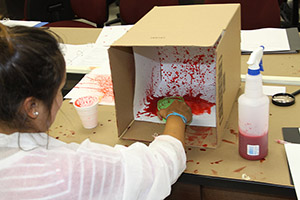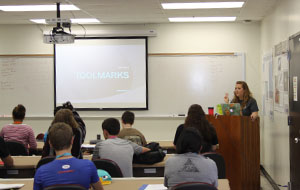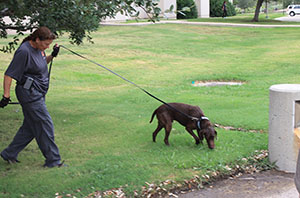
Students learned how to measure bloodspatter patterns during one of many hands-on activities during the camp. Photo by Rob Williams
COLLEGE STATION, Texas — Members of the Dr. Jeff Tomberlin’s FLIES Facility and Dr. Aaron Tarone’s lab helped youths understand how forensic science worked as they taught the Investigative Forensics portion of the Youth Adventure Camp during the last week of July.
The week the labs held the event was part of a series of weeklong courses designed to help gifted and talented youths to explore various careers through interesting demonstrations and hands-on activities. The program encourages students to be highly motivated to learn, think and solve problems and have a strong interest in attending college or professional school in the future.
This was the second time that Tarone Lab member and grad student Ashleigh Faris has assisted with the camp. Her favorite part of the camp is seeing the students apply what they have learned in her demonstrations and lectures during the lab times.
“I think this is a great way to introduce them to forensic science and let them see all the disciplines forensics offers,” Faris said. “This lets them see if this is something that they want to do in the future.”
Students worked several hands-on activities including making and measuring their own fingerprints, studying the effects of bloodspatter patterns on different media and tool mark identification. The students then were asked to solve a mock crime scene using what they have learned throughout the week and then present their findings to the class.
Other topics included introductions to the world of forensic science, using DNA for forensics, analyzing questioned documents, forensic anthropology and forensic entomology. During the final session, students got a chance to see a live demonstration of search and rescue dogs led by volunteers Tawni (T.C.) Crippen, Cindy Sheffield, and Jennifer Blanton.
Some of the topics the volunteers covered included how search and rescue personnel used canines under different situations, what goes into making a good search and rescue dog, and how they train their dogs.
Crippen and Sheffield then held a short live demonstration with their dogs named “Wink” and “Seeker.”
Tomberlin was very impressed with this year’s students and said that they were excited and very eager to learn about forensic and investigative sciences techniques.
“This year’s students are phenomenal. I always appreciate their energy and interest in learning about forensics.”
He also said that the Youth Adventure Program was a great outreach opportunity for his lab.
“YAP is a wonderful opportunity for graduate students and postdoctoral associates to gain experience in the classroom and learn the value of translating science to the general public,” Tomberlin said.
Postdoctoral Research Associate and camp coordinator Jonathan Cammack was very impressed with this year’s camp and said the hard work was worth it.
“The camp was a tremendous amount of work to organize, but after seeing how much the students enjoyed learning about different aspects of forensic science, the hard work of the other instructors and myself was well worth it,” he said. “This year’s groups of students were top-notch; they were very intelligent, inquisitive, and a blast to have worked with for the week. I can’t wait for next year.”
Cammack said that the program was a great way to teach and expose youth to forensic and investigative sciences.
“The Youth Adventure Program provides a great opportunity for us to teach, and more importantly, inspire others about forensic science,” he said. “I hope that our effort leads to each and every one of these students pursuing college degrees, and eventually careers, in some aspect of forensic science. The quality of this year’s students bodes well for the future of forensic science.”


